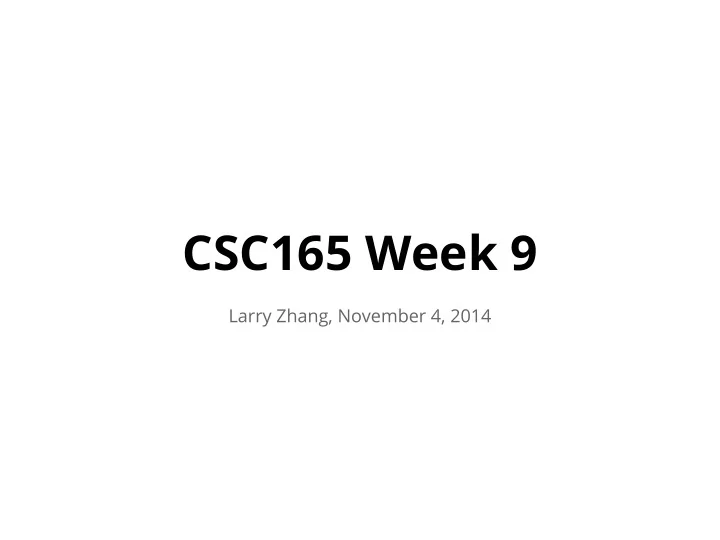

CSC165 Week 9 Larry Zhang, November 4, 2014
today’s outline ➔ exercises of big-Oh proofs ➔ prove big-Oh using limit techniques
Recap definition of O(n²) Beyond breakpoint B , cn² f(n) is upper-bounded by cn² , where c is some f(n) wisely chosen constant multiplier. B
Notation of O(n²) being a set of functions functions that take in a natural number and return a non-negative real number beyond breakpoint B, f(n) is upper-bounded by cn² set of all red functions which satisfy the green.
Prove thoughts: it’s all about picking c and B ➔ tip 1: c should probably be larger than 3 (the constant factor of the highest-order term) ➔ tip 2 : see what happens when n = 1 ➔ if n = 1 ◆ 3n² + 2n = 3 + 2 = 5 = 5n² ◆ so pick c = 5 , with B = 1 is probably good ◆ double check for n=2,3,4…, yeah it’s all good
Proof # 3n²+2n ≥ 0 when n is natural number # 5 is a positive real # 1 is a natural number # generic natural number # the antecedent # 2n x 1 ≤ 2n x n since 1 ≤ n # c = 5 # transitivity of ≤ # introduce antecedent # introduce ∀ # introduce ∃ # by definition
what if we add a constant? Prove thoughts: it’s all about picking c and B ➔ tip 1: c should probably be larger than 3 (the constant factor of the highest-order term) ➔ tip 2 : see what happens when n = 1 ➔ if n = 1 ◆ 3n² + 2n + 5 = 3 + 2 + 5 = 10 = 10n² ◆ so pick c = 10 , with B = 1 is probably good ◆ double check for n=2,3,4…, yeah it’s all good
Prove large thoughts: ➔ assume n ≥ 1 ➔ upper-bound the left side by overestimating ➔ lower-bound the right side by underestimating ➔ choose a c that connects the two bounds small
Proof # non-negative for n ≥ 0 # n ≥ B, the antecedent # -5n⁴ ≤ 0 # n³ ≤ n⁶ since n ≥ 1 # c = 9/2 # -n⁸ ≤ -n⁵ # 0 ≤ n²
how about disproving?
Prove ➔ first, negate it ➔ then, prove the negation
Prove thoughts
Proof: # definition of max # definition of max and ceiling # multiply both sides by n² > 0 # conjunction introduction # introduce ∃ # intro ∀ # definition of big-Oh
summary ➔ the ways we talked about of picking c and B , the main point of them is that we know how to show the bounding relation when picking in these ways. ➔ these are not the only ways, you can be more flexible when you are more familiar with these types of proofs. ➔ In general, larger c or larger B don’t hurt.
so far all functions we talked about are polynomials ➔ between polynomials, it is fairly easy to figure out who is big-Oh of whom ➔ simply look at the highest-degree term ➔ f(n) is in O(g(n)) exactly when the high- degree of f(n) is no larger than that of g(n)
polynomials
how about non-polynomials?
but how do we prove it? ➔ we need to use a math tool, which we didn’t like a lot but studied anyway
f(n) g(n) Intuition: ➔ if the ratio approaches infinity when n becomes larger and larger, that means f(n) grows faster than g(n)
This is sort-of related more precisely to the definition of big-Oh… the ratio is give me I can find a beyond bigger than any big breakpoint which that big number number
How to use limit to prove big-Oh General procedure 1. prove using “some calculus” 2. translate the limit into its definition with c and n’, i.e., 3. relate this definition to the definition of big-Oh, i.e., means
http://mathworld.wolfram.com/LHospitalsRule.html Step 1. prove using “some calculus” “some calculus”: L’Hopital’s rule derivatives l’hopital l’hopital again!
Step 2. translate the limit into its definition we have proven then by definition of limit the ratio is give me I can find a beyond bigger than any big breakpoint which that big number number
Step 3. relate it to the definition of big-Oh what we have we have this awesome n’, all n ≥ n’ satisfy 2^n > cn² pick n = max(n’, B) wanna pick a wise n to satisfy both
Proof: # generic c and B # applying L’hopital’s rule twice, (show the steps, omitted here) # definition of limit # definition of max # definition of max # definition the limit # conjunction introduction # intro ∃ # intro ∀ # negation of definition of big-Oh
next week ➔ more proofs on O, Ω, Θ ➔ (maybe) computability
Recommend
More recommend